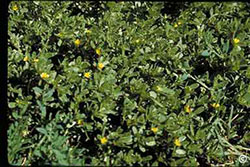What is purslane?

Purslane is a spreading annual weed that germinates after soil warms in early summer. A native of Europe, purslane is related to the portulaca or moss rose grown in flower gardens. It has succulent leaves and a low-growing, mat-like growth habit. Clumps may grow to two feet in diameter.
How can I identify purslane?
Purslane is a problem weed in flower and vegetable gardens, where it competes with desirable plants for moisture. It’s also frequently seen in newly-seeded lawns. Stems and leaves often have a reddish-purple tint, and the small yellow flowers open only on bright sunny days. Purslane thrives when it has plenty of moisture. It also can survive in dry spots, although it may be less vigorous and have smaller leaves.
How can I get rid of purslane?
Purslane produces high numbers of very small, brown to black seeds that may remain viable in the soil for up to 40 years. A single plant can produce thousands of seeds. Therefore, the best control for purslane is to keep it from producing seed. You can hoe it out of your garden, but it can redevelop from the taproot left in the soil. Plants pull out of moist soil easily, but it is important to bag and discard pulled plants, as those left on a moist soil surface can re-root. Hoe or pull purslane as soon as it’s identified and before flowering occurs.
Do herbicides kill purslane?
Pre-emergent herbicides are not very effective as purslane seeds rarely germinate early enough in the season. Herbicides such as glyphosate, sold as Roundup, and 2,4-D sprayed on this weed can be effective, but seeds may mature in the time it takes for an herbicide to kill the plant. Purslane rarely develops in mulched areas, and mulch placed over purslane usually will smother it. There is a hornworm, similar to tomato hornworm, that feeds on purslane, but rarely does significant damage.
Purslane does have a silver lining. Its leaves are nutritious and edible, they make a nice addition to salads.



